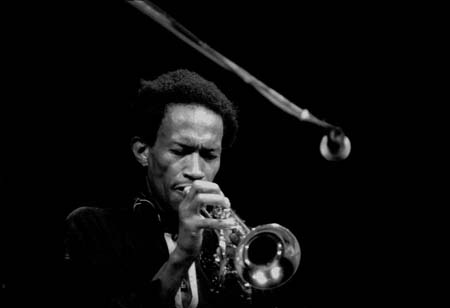The Demands of Style
On September 13, 2008, after an evening of accolades from friends, colleagues, and admirers, Leo Smith raised his horn and let out a characteristic blast–clear and long, warm and penetrating, aggressive but not piercing to the ear. His duo partner, percussionist Pheeroan akLaff, played counterpoint. The paradox of Leo’s style is that it is at once mystical and precise. Each attack is carefully placed in time, yet the rhythmic underpinning of tempo is entirely imaginary. Though the trumpet sound itself is clarion, the overall impression is of philosophical reserve. This is a style that Leo invented, and the mystical effect has something to do with the fact that he taught himself to play this way.
By coincidence or by design, September in New York offered the chance to hear many trumpeters. On a lot of the gigs they played side by side. It was a unique opportunity to observe variations in style–style not in the sense of ‘genre,’ but rather of “personal style” or the way each person plays. Personal style often includes elements of genre, but it seems much more noticeable in individuals who, like Leo, create a new pathway to their own music.
It was kind of astounding to see so many radically varied approaches to this one instrument. Hearing 35 trumpeters in 14 days, I came to some thoughts about style, how it’s found, some new ways it operates, and why it is so important to today’s music scene. At its best, it’s the singular sound that makes a musician recognizable.
Something that often goes unmentioned is the long road players and composers take to arrive at their choice of materials, and the opportunities this process offers for new music. Listening and understanding new music in this era requires a consideration of those forces–not necessarily for the enjoyment of the music, but to go deeper into its meaning and purpose. Maybe because the trumpet is so nakedly exposed in an ensemble and so molded to the physique of the player, these differences in personal style show up in stark relief. In any case it was in listening to and considering all those trumpeters that these thoughts arose.
It is said that the walls of high and low art tumbled long ago–that all genres are now equal in terms of validity, though there remain vestiges of the old categories. Most artists today would agree that all ways of working and all historical approaches are worthy of study. ‘Pan-stylism’ is a word that has recently been bandied about to describe the current period.
If that’s true–-that we really are past the validity argument in music–-then a personal style can be constructed from among all the available materials, including all sonic as well as genre areas. No single kind of music or sound can be excluded nor be charged with being exclusionary. This engaged tolerance is more and more common among New York’s (and the world’s) polyglot communities, and the result is the heterogeneous climate of current culture. No one wants to be limited, no matter how much they profess commitment to their own tradition or style.
Even though many musicians today would claim to play in all styles (and regardless of our assessment of the claim, musicians always do somehow create from an amalgamation of voices), there are physical limitations. Much as I love Hendrix, it’s unlikely I will ever get that sound out of my horn. More to the point, different sorts of music have different physical demands and require different skills. Eventually a trumpeter has to commit to a certain kind of playing, a specific sound world. The imperatives may be only partially physical–-economic and social forces are also at play. A musician may hear and accept most music, but when it comes time to play he or she can only play one way at a time. Many forces come into play at that moment.
In moving beyond the tropes of genre separation and social segregation, musicians are then left with tough musical and personal decisions about the demands of style in the choice of what to play. Empowered by the freedom of self-definition and by the agency to move through disparate musical realms, artists are faced with ever more urgent decisions about developing a personal style or voice. One of the most frequently asked questions about making music in this age is: How do I choose?
The results of that choice (as well as perhaps its causes) bear out in social and professional networks. Who do they play with? Who is in their circle of friends? How much do they limit their outlook and how willingly do they challenge the boundaries? Falling into a certain scene or professional milieu can make the decision simple. But barring that it is a perplexing environment for a musician, and obviously in the case of finding a personal music, there’s no one to give you an answer.
This is not the first generation of musicians to encounter these pressures. This has been going on for a long time in improvisational music, but increasingly among modern classical musicians and traditional folk-trained players as well. More and more there are exceptional players and composers who develop deep understandings of multiple traditions in order to forge a new language. What is unique in our time is that this melding has become the accepted way of doing business. We’re witnessing a generation synthesizing all the disparate elements to leap over this problem into a new music as yet unheard.
As can be heard in all these trumpeters, the development of a personal style is integral to that process. The demands are self-imposed. The technical challenges are unique to each individual. At the end of the day, a musician will be the only one who sounds quite that way, as the sound will be a result of an arduous journey through the world and the self. It makes for some wonderful music, as it’s about finding that one voice that truly represents a musician’s sound.
Under the leadership of improvising conductor Butch Morris, fourteen trumpeters (myself included) joined forces on September 23 at BRIC Studio in Brooklyn. Hearing each trumpeter alone stripped bare the sharp contrasts between them. Paolo Fresu, alternately on flugelhorn, played dark tonal melodies that seemed to rise from a primordial urge, pure and sweet. Jamie Branch altered her tone into a buzzing, clattering heap of sound, with fragments of metal variously covering and framing the bell of her horn. Taylor Ho Bynum mostly on cornet used wildly changing half-valve techniques and sputtering growls to make a constantly shifting blur of notes. Amir ElSaffar, with a specially built quartertone instrument, alluded to, without quite playing, the scales and maqams of Arabic music. Wilmer Wise’s perfectly executed tones, the voice of a long and rich symphonic experience.
In retrospect, it was emblematic of the wide world that the music scene now is: the variety of approaches and the intensity with which each player confronts the challenges of their particular direction, the acceptance that with an artistic decision about style comes a unique set of technical problems, and the willingness to face those risks. It seems there is no universal value system whereby one kind of music or tradition is good and others bad. There is only the value of how much commitment and vitality each artist brings to the path. That is one of the most inspiring aspects of our age.
On September 14 at the Louis Armstrong House Museum in Corona, Queens, Eddie Allen, Cecil Bridgewater, and James Zollar played Eddie’s rearrangements of Armstrong classics. His approach covered the waterfront, from odd-metered refractions, to Latin-tinged reconsiderations, to straight-up post-post-modern swing playing. It took three very specially trained players to negotiate all the ramifications. It was New Music in the most enjoyable sense–music made fresh by the power of personal research and practice.

